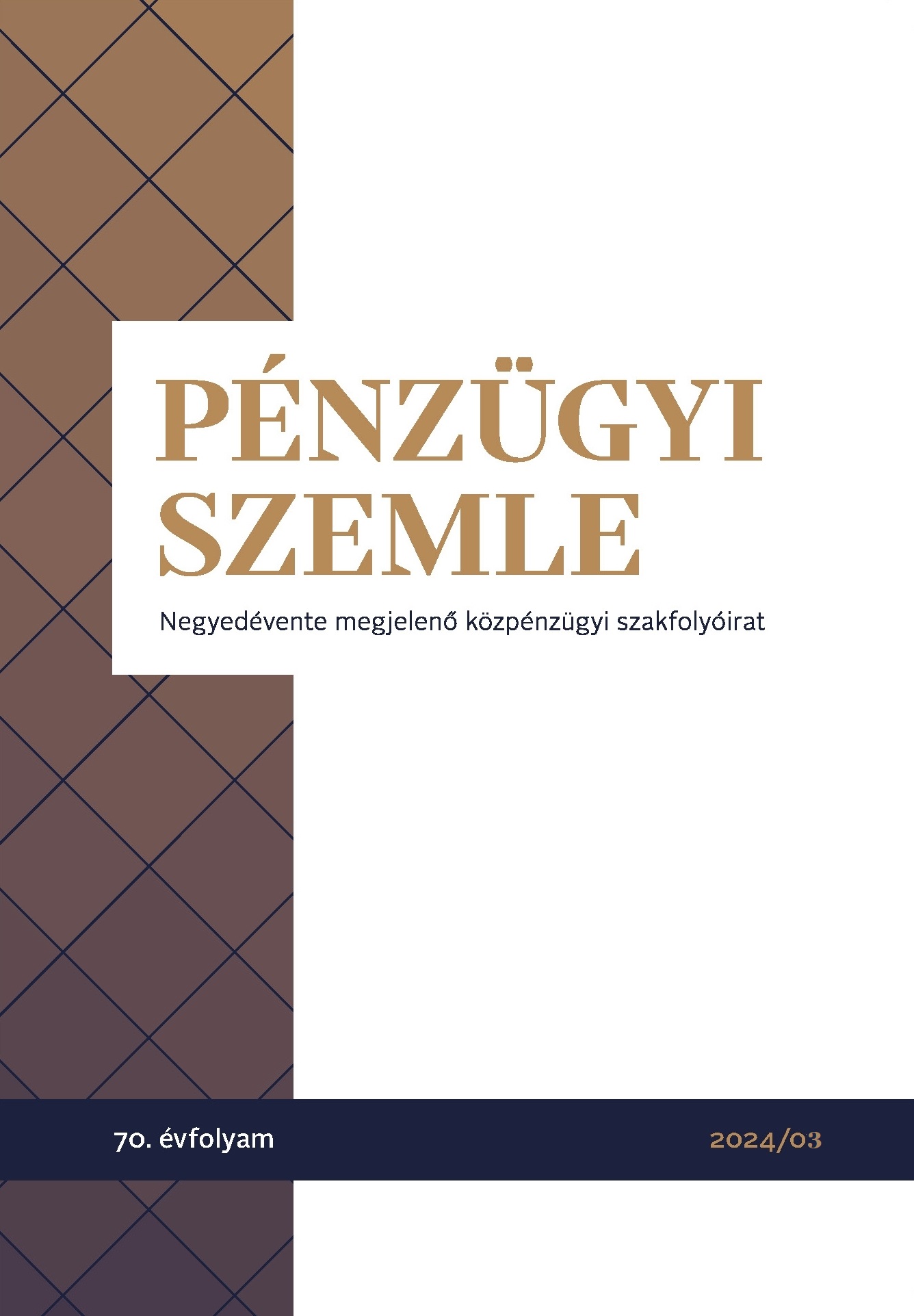The impact of capital gains manipulation on the financial reporting of football clubs – the Plusvalenza case and Juventus
DOI:
https://doi.org/10.35551/PFQ_2024_3_6Keywords:
playing rights, capital gains, capital gains manipulation, sports management, L83, M41, Z23Abstract
In recent decades, football has attracted huge numbers of spectators and has become an increasingly popular sport among sports fans, a major entertainment industry and a growing concern for its financial sustainability. When assessing financial stability, it is essential to ensure that the financial statements are adequate, reliable and present a true and fair view.
Playing rights are considered to be an indispensable resource for football clubs, but their evaluation is highly subjective. This also undermines the reliability of reporting and provides scope for manipulation of capital gains. This latter phenomenon has been evident in the operation of European football clubs, the most notable of which is Juventus. In this paper, we will attempt to examine the case of Juventus through a case study analysis, highlighting how the pricing of playing rights can help to portray a club’s wealth, income and financial situation in a more favourable light, and the short and long-term consequences of manipulation.
References
Babbie, E. (2001). A társadalomtudományi kutatás módszertana. Balassi Kiadó, Budapest
Bowen, G.A. (2009), Document Analysis as a Qualitative Research Method, Qualitative Research Journal, 9(2), 27-40. https://doi.org/10.3316/ QRJ0902027
Denich, E., Budai, E. & Baracsi, Á.L. (2023). Az earnings management gyakorlatának vizsgálata amerikai tőzsdei vállalkozások példáján keresztül. STATISZTIKAI SZEMLE, 101(1), 30-52.
Denich, E. & Hajdu, D. (2021). A kreatív számvitel alkalmazásának vizsgálata Transparency and Disclosure Index (TDI-) módszer segítségével autóipari cégeknél. Pénzügyi Szemle, 66(3), 390-405.
Deloitte (2023a). Deloitte Football Money League 2023. Online: https://www2. deloitte.com/uk/en/pages/sports-business-group/articles/deloitte football-money-league.html
Deloitte (2023b). A balancing act. Annual Review of Football Finance 2023Online: https://www2.deloitte.com/content/dam/Deloitte/uk/Documents/ sports-business-group/deloitte-uk-annual-review-of-football finance-2023.pdf
Feess, E., & Muehlheusser, G. (2003). The Impact of Transfer Fees on Professional Sports: An Analysis of the New Transfer System for European Football. The Scandinavian Journal of Economics, 105(1), 139–154. http://www.jstor.org/ stable/3440925
Franceschi (2020). The Plus-valenza case: a call for regulation for the blurred value of football players. Working paper. Online: https://www.researchgate. net/publication/372951480_THE_CAPITAL_GAINS_CASE_A_CALL_FOR_ REGULATION_FOR_THE_BLURRED_VALUE_OF_FOOTBALL_PLAYERS
Franceschi, M., Brocard, J.F., Follert, F. & Gouguet, J.J. (2023). Determinants of football players’ valuation: A systematic review. Journal of Economic Surveys. https://doi.org/10.1111/joes.12552
Francheschi, M., Giuffré V. (2023). The „Capital Gains” Case: A Call for Regulation for the Blurred Value of Football players. Rivista di Diritto ed Economia dello Sport, 19.
Franck, E. & Nüesch, S. (2011). The effect of wage dispersion on team outcome and the way team outcome is produced; Applied Economics, 43(23),pp 3037–3049;
Frick, B. (2007). THE FOOTBALL PLAYERS’ LABOR MARKET: EMPIRICAL EVIDENCE FROM THE MAJOR EUROPEAN LEAGUES. Scottish Journal of Political Economy, 54(3), pp 422-446
Fűrész, D. I. (2018). Correlation between profitability and transfer activity in European football. Croatian Review of Economic, Business and Social Statistics, 4(2), pp 15-22. https://doi.org/10.2478/crebss-2018-0009
Fűrész, D. I. (2021). Sztárigazolások eredményességre gyakorolt hatásának modellezése az európai labdarúgás példáján keresztül. Doktori Értekezés, Pécsi Tudományegyetem Egészségtudományi Doktori Iskola, Pécs
Fűrész, D.I. & Rappai, G., (2022). Information leakage in the football transfer market. European Sport Management Quarterly, 22(3), pp 419-439. https://doi. org/10.1080/16184742.2020.1797847
Jakusné Harmos É. (2023). A dokumentumelemzés módszertana a hadtudományi tanulmányok készítéséhez. Hadtudomány 33, 157-172. https://doi.org/10.17047/ Hadtud.2023.33.E.157
Kovács Zs. I. & Lippai-Makra E. (2023). Intellectual capital disclosure and non financial reporting – current issues related to policymaking. PROSPERITAS 10(3). | https://doi.org/10.31570/prosp_2022_0048
Kovács Zs. I.& Deák I. (2012). Számvitel – szakma versus tudomány. Pénzügyi Szemle, 51(4), pp 458-468.
Kovács, Zs. I., (2015). Immateriális vagyonelemek a magyar számviteli rendszerben és a beszámolókban. Pénzügyi Szemle, 54(2), pp 231-242.
Kovács, Zs. I., Lippai-Makra, E., Kiss, G.D. & Deák, I., (2021). Az immateriális javakkal kapcsolatos közzététel vizsgálata tartalomelemzéssel a legnagyobb hazai vállalkozásoknál. GAZDASÁG ÉS PÉNZÜGY, 8(1), pp 88-112. https://doi. org/10.33926/GP.2021.1.4
Limba, F.B. & Sapulette, S.G. (2021). European Football Player Transfer Scheme according to IFRS and IAS: Case Study on Juventus Football Club SpA. Budapest International Research and Critics Institute-Journal (BIRCI-Journal), 4(4), pp 12355- 12365.
Nagy Z.I. 2011. A professzionalista futball finanszírozási sajátosságai. Pénzügyi Szemle, 50(4), pp 524-570.
Poli, R., Besson, R. & Ravenel, L. (2021). Econometric approach to assessing the transfer fees and values of professional football players. Economies, 10(4). https://doi.org/10.3390/economies10010004
Rodov, I. & Leliaert, P. (2002). FiMIAM: financial method of intangible assets measurement. Journal of intellectual capital, 3(3), pp 323-336. https://doi. org/10.1108/14691930210435642
Rosen, S& Sanderson, A. (2001). Labour Markets in Professional Sports. The Economic Journal, 111(469), pp 47–68, https://doi.org/10.1111/1468-0297.00598
Rubio Martin, G., Manuel García, C.M., Rodríguez-López, Á. & Gonzalez Sanchez, F.J. (2022). Measuring football clubs’ human capital: analytical and dynamic models based on footballers’ life cycles. Journal of Intellectual Capital, 23(5), pp 1107-1137. https://doi.org/10.1108/JIC-06-2020-0211
Simmons, R., (1997). Implications of the Bosman ruling for football transfer markets. Economic Affairs. 17(3), pp13-18.
Simmons, R., (2007). Overpaid athletes? Comparing american and european football. WorkingUSA, 10(4), pp 457-471.
Sloane, P. J. (1971). THE ECONOMICS OF PROFESSIONAL FOOTBALL: THE FOOTBALL CLUB AS A UTILITY MAXIMISER. Scotthis Journal of Political Economy, 18(2), pp 121-146.
Sloane, P.J., (2006). Rottenberg and the economics of sport after 50 years: An evaluation. IZA Discussion Papers 2175, Institute of Labor Economics (IZA).
Solberg, H. A. & Haugen, K. K. (2010). European club football: why enormous revenues are not enough?, Sport in Society: Cultures, Commerce, Media, Politics, 13(2), pp 329-343
Takács F. (2017). Az esettanulmány mint módszertan a szociológiában. Szociológiai Szemle, 27(2) 126-132.
Torgler, B. & Schmidt, S. L. (2007). What shapes player performance in soccer? Empirical findings from a panel analysis; Applied Economics, 39(18), pp 2355–2369.
Tóth, N.Á. & Mátrai, G., (2023). A magyar sport finanszírozásának rendszere, különös tekintettel a közpénzügyi vonatkozásokra. Pénzügyi Szemle,69(2), pp 84- 102. https://doi.org/10.35551/PFQ_2023_2_5
UEFA (2023). Club Licensing and Financial Sustainability Regulations. Online: https://documents.uefa.com/r/UEFA-Club-Licensing-and-Financial Sustainability-Regulations-2023-Onlin
Downloads
Published
How to Cite
Issue
Section
License
Copyright (c) 2024 Public Finance Quarterly

This work is licensed under a Creative Commons Attribution 4.0 International License.
Authors assign copyright to Pénzügyi Szemle / Public Finance Quarterly. Authors are responsible for permission to reproduce copyright material from other sources.












